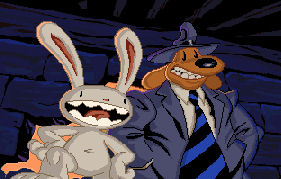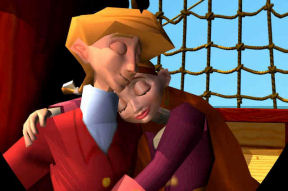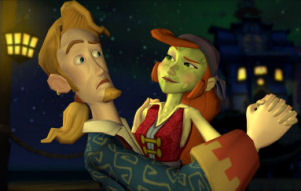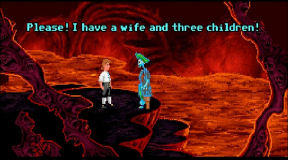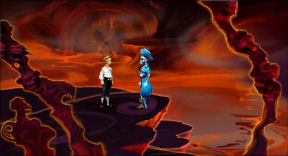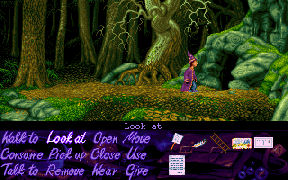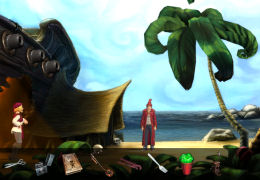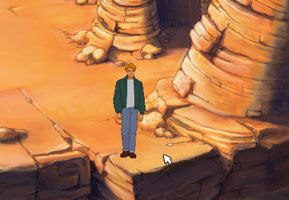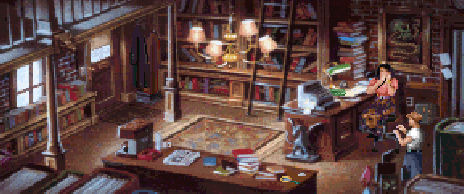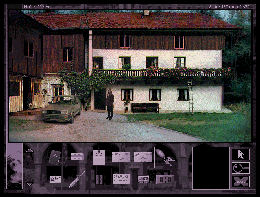|
In with the Old: The Classics and Adventure Gaming By Becky Waxman
Gabriel Knight. Tex Murphy. Simon the Sorcerer. Sam & Max. Monkey Island. Classic adventures with something in common. The first three series I just mentioned are now available in their original versions, but updated to run on current gaming systems at Good Old Games. Updating classics so they'll run fuss-free on current machines may seem to be a no-brainer. Yet until recently, it was a relative rarity. Simon the Sorcerer, Sam & Max and Monkey Island have gone a step further, with recent sequels produced after a long gap. There were fourteen years between Sam & Max Hit the Road and Sam & Max Save the World (Season One). Nine years between Escape from Monkey Island and Tales of Monkey Island. Six years between Simon the Sorcerer 3D and Simon the Sorcerer 4: Chaos Happens.* Adventure classics updated to run on current systems, and a sudden resurgence in the release of sequels to certain classics -- what do these developments mean for the overall health of the Adventure Game genre?
Not Dead and Not Gone When Sierra and LucasArts stopped making adventure games more than a decade ago, the mantra of "Adventure games are dead" emerged. Meanwhile, members of the adventure community went on quietly playing adventure games by other developers, which released at an average clip of more than 50 per year. With the sequels mentioned earlier, plus a number of series going strong (e.g., Nancy Drew, Sherlock Holmes), isn't it time to put the "Adventure games are dead" drumbeat to rest? With what looks like an increasing proliferation of renewed classics -- added to the adventure offerings that have been released all along during the "Are we dead yet?" decade -- the adventure genre is certainly looking alive.
How Special is the Edition? Then there's this development -- LucasArts is not only re-releasing some of their classic adventures on Steam -- the company is also releasing special editions of other classics. So far we've seen The Secret of Monkey Island Special Edition, which released via Steam in 2009, plus the recent announcement of Monkey Island 2: LeChuck's Revenge Special Edition, available later this summer. These special editions contain the original game, new voiceovers (the originals contained text but not voices), a new hint system and modernized graphics. You can switch back and forth at any point between the original gameworld and the contemporary, higher definition gameworld. The upcoming LeChuck's Revenge Special Edition will also contain commentary on the game by the original designers. Reworking a classic is tricky, particularly because gamers' memories are sometimes tinged with a large dollop of nostalgia. Every gamer internalizes the gaming experience, making it almost impossible to recreate that experience with a revamped game. Designers promoting special editions with significant "improvements" are competing directly with gamers' fond memories. Before playing The Secret of Monkey Island Special Edition, I thought that developer time would best be spent on a new adventure game, rather than buffing and polishing an old one. However, I found that playing the special edition brought back memories while adding a level of enjoyment that was noticeably absent from the original version. The voiceovers in particular make the game well worth playing again (or experiencing for the first time). I now think that when an older game's story, dialogs and gameplay are this engaging, it's worth recrafting it for a new audience, particularly if that new audience can't easily play the original game on current systems. What criticism I've read of The Secret of Monkey Island Special Edition is directed toward the modernized graphics, which don't fit some gamers' impression of how a "revisualization" should appear. Some gamers prefer to replay with the original graphics, and feel that revamping the graphics dishonors the original intent (like "colorizing" black and white films). I understand this view, but I can't help thinking that the original intent was so limited by the (then current) technology that pixelated graphics in 256 colors was a compromise, not a grand artistic vision. The Monkey Island special editions satisfy both camps. Nostalgic gamers may use the original graphics, and switch to the modernized version to snicker at the inauthenticity of the revamp. Others may play using the updated graphics, and occasionally switch to the original version and marvel at how much graphics engines have improved. If you never played the originals because you weren't gaming in the 90s or (in later years) you didn't want to have to try to work with an emulator, you can play the special edition any which way you want and find out what all the fuss was about. Almost everybody is happy.
That's not a Blob, it's my Face! (Classics Played for the First Time, A Decade or Two After Initial Release) So we're seeing a resurgence in sequels for adventure series that had gone on hiatus for many years. Plus special editions that rework classic adventures and add new features. Plus access to classic adventures downloadable from places like Good Old Games. Since they're now readily available without complex tweaking required, many adventure gamers are starting to play classic adventures and experiencing them for the first time -- without updated graphics or gameplay. Playing the adventure classics -- without a special edition remake -- is a different experience than playing a special edition or a modern sequel, because the gamer then must adjust to earlier graphical and gameplay conventions. So perhaps a disclaimer for the intrepid adventurer trying a classic adventure for the first time is in order. Gamers who never had the chance to play the classics sometimes purchase them, having heard others rave about them for years, and then find that the graphics look, well ... old! Pixelated, blurry, even washed out. If you haven't played many games from, say, 1993, you may expect that a game everyone says is one of the best of all time ought to look like it's from, say, 2005. Some of these classics had cutting edge graphics at the time that have managed to "age" well. But others became classics because of their stories, characters, or gameplay. It can take a while to adjust to the old-fashioned graphical environments before the game's good points can be appreciated by a gamer who's playing it for the first time. Another issue: older adventures often have complex interfaces, at least when compared to today's games. It can be surprisingly cumbersome to do simple things -- like walk through an unlocked door. Or you may find yourself trying every hotspot in the environments with a laundry list of verbs -- pick up the lamp, push the lamp, talk to the lamp, open the lamp, use the lamp, eat the lamp, kick the lamp....
So Why Attempt the Classics in their Original Versions? Should you leave older adventures on the shelf? No way! Consider the compensations -- I've listed a few below. Many classic adventures tell great stories, and some have characters who are unforgettable. (Here's looking at you, George Stobbart.) Others have engaging, brilliantly offbeat, yet logical puzzles. (Grim Fandango's Land of the Dead integrates puzzles better than anywhere else on Earth.) It can be fascinating to trace the history of the genre by playing through the games that left their mark. You may find yourself more appreciative of current conventions -- thank goodness unlocked doors now open with a single click. Plus, there's always a chance that you'll find that you'll enjoy the complexities of these old-fashioned classics, welcoming their traditional rigor
The Internet, Changing Tastes and Access to the Classics Why are we suddenly seeing an interest in re-releasing, revamping, and even creating new sequels for classic adventure game series? There are four factors provoking this. The first is digital distribution. Via online distribution, older games can be tweaked by the distributor and then released with relative ease. Without this "minimal fuss" distribution channel, we wouldn't have a legal and increasingly abundant supply of classic adventures. It's a lot easier for classics to find an audience if the publisher/distributor doesn't have to produce the physical disks, design the box, arrange for shipping, and fight for a slot on the limited shelf space globally. I also suspect a re-examination of (and rekindled appreciation for) 2D/2.5D graphics is fueling an interest in the classics. If the industry declares that photorealistic 3D graphics alone are worthy, it doesn't make any sense to resurrect the old 2D games. Part of the classic adventure resurgence is a result of a recent slackening of, um, 3D snobbery. (Perhaps augmented by complaints from gamers who don't have the very latest graphics cards.) The third contributing factor is the fan base, and its ability to make its presence known on the internet. Even a relatively small fan base can have an effect. Are Monkey Island fans, for instance, fewer in number than Star Wars fans? Yes indeed. (And likely to remain so -- at least until we've seen six Monkey Island films enjoying global releases.) But that doesn't mean that Monkey Island fans can't generate buzz and excitement, post what they're thinking in online forums, bring in new fans, and ultimately make Monkey Island a profitable franchise. Until recently, I suspect that publishers have been underestimating the fan base. They may now be figuring out how to better tap into a particular game's community, resulting in long-term increases in game sales, leading to new confidence in re-releasing, revamping and continuing classic adventure franchises. Factor four is financial: companies wouldn't be developing sequels or special editions if they didn't think they could make money doing it (especially true at a time when the global financial crisis is still very much with us). So those of us who have been BAAGing for more than a decade have had a part in keeping the genre alive. As have the developers who contributed the 50+ adventure games per year during good times and bad, even when fate seemed set against the genre. They ultimately took the risks that paid off for all of us.
Net Positive? A living, fertile genre will always be subject to uncertainties and changes, and new issues will surely surface. Will the easy availability of the classics mean that more gamer dollars go toward the classics, reducing the sales of new games? Will ready access to older games vastly increase the fan base and make it more powerful, multiplying the reach and popularity of upcoming sequels? Will special editions with designer commentary become as common in gaming as disks containing special features are for films released on DVD? Will more developers adopt the special edition concept? (As I was writing this editorial, Her Interactive announced that they will be revamping the first Nancy Drew adventure, Secrets Can Kill, with improved graphics and new puzzles, so this trend is going strong.) Overall, I think that the adventure genre returning to its roots -- re-exploring and reinventing the classics -- is a positive trend, particularly if this is trend doesn't start to crowd out releases of new, original adventure games and series. Everything old is new again, and this will keep the genre thriving. *Information for this article was gathered from the Pagoda Adventure Game Database, Moby Games and Wikipedia.
|
